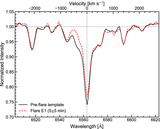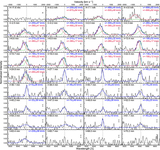Image Details

Caption: Figure 22.
Mass and kinetic energy of solar/stellar filament/prominence eruptions and CMEs as a function of bolometric WLF energy or GOES X-ray energy. The green and red points correspond to the stellar prominence and filament eruptions on EK Dra, respectively (this study, Namekata et al. 2022d). The black crosses are solar CME data (Yashiro & Gopalswamy 2009; Drake et al. 2013), while the green pluses are data for solar prominence/filament eruptions taken from Namekata et al. (2022d) and Kotani et al. (2023). The cyan dashed and magenta dotted lines are observational fits for solar CMEs expressed as ﹩{M}_{\mathrm{CME}}\propto {E}_{\mathrm{bol}}^{0.59}﹩ and ﹩{E}_{\mathrm{kin}}\propto {E}_{\mathrm{bol}}^{1.05}﹩ (cyan color; Drake et al. 2013) and ﹩{M}_{\mathrm{CME}}\propto {E}_{\mathrm{bol}}^{0.7}﹩ (magenta color; Aarnio et al. 2012). The relations of E kin = E bol, E kin = E bol/10, and E kin = E bol/100 are also plotted in gray in the right panel. Here, GOES X-ray energy/flux is related to bolometric energy with the relations of E bol=100 E GOES (Emslie et al. 2012) and E bol [erg]=1035 F GOES [W m−2] (Shibata et al. 2013) to connect solar data to stellar data. Also, we assume bolometric energy ≈bolometric WLF energy (Kretzschmar et al. 2010; Kretzschmar 2011; Osten & Wolk 2015).
Copyright and Terms & Conditions
© 2024. The Author(s). Published by the American Astronomical Society.












